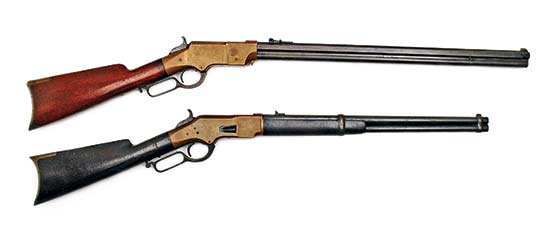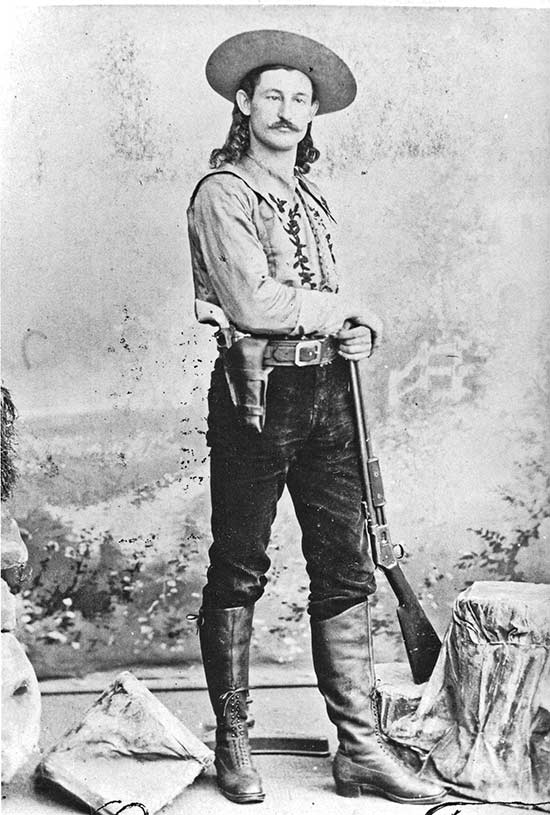Chicken Or Eggs
Which Came First? 'Pistol' Calibers Or Carbines?
His Editorship, Roy, and I were both surprised at how much response was generated by my piece on pistol caliber carbines (Nov/Dec 2017). It seems you wanted more, though, on vintage and modern versions. That first article was a quick overview, but now Roy has tasked me with tackling the topic again, covering some more history and then in the future, modern versions.
Let’s talk history first. It’s like the “Which came first — chickens or eggs?” question. The actual fact is rifles taking pistol-size cartridges came first. That was in 1862 with the Henry .44 Rimfire, followed in 1866 with the first Winchesters, also firing the .44 Henry round. It wasn’t until 1870 S&W introduced their first big-bore revolver. It was named the Model #3 and was also chambered for the .44 Henry Rimfire. Colt followed suit in 1872 with their short-lived Open-Top. Those developments got the concept of rifle/revolver combinations firing the same ammunition going.
Modern archaeology done at the Little Bighorn Battlefield in the late 20th century revealed the Sioux and Cheyenne warriors fired literally thousands of .44 Henry Rimfire rounds at the 7th Cavalrymen that day in 1876. Forensic testing proved most were fired from Henrys and Model 1866 rifles/carbines, but some were from revolvers. This is evident by firing pin strikes. Of course that begs the question: Were some of those warriors packing long gun/revolver combos? We’ll never know for sure, but my guess is they were.
Today near perfect replicas of Henrys can be had from Henry Repeating Arms of New Jersey or from several importers bringing them in from the Uberti factory in Italy. Both are now made for .44-40s (.44 WCF) due to the non-existence of .44 Henry Rimfire ammunition. However, when loaded with black powder their power and recoil is about equal to the old Henry .44. Replica Henrys from Italy also are offered in .45 Colt.
Those “Pistol” Calibers
When Winchester introduced their Model 1873, first with .44 WCF, then .38 WCF (.38-40) in 1879, and .32 WCF (.32-20) in 1882 they didn’t make the cartridges small so people could also have handguns chambering the same ones. They did so because those rounds would fit in a reasonably sized, iron — and later steel frame — repeating rifle of that time. My bet is they didn’t give a hoot whether Colt or anyone else could use them in revolvers.
Marlin, Colt, Burgess and Whitney/Kennedy also borrowed Winchester’s cartridge developments. In fact Colt really put their thinking cap on and developed their radically different pump named the Lightning. Its medium size frame version chambered, of course, the .32, .38 and .44 WCFs. In fact with a few exceptions those three WCF pistol size rounds were the only three handgun cartridges used in repeating long guns until about mid-20th century.
Actually there was one other, and it seems an odd one from our modern perspective. It was Winchester’s full size Model 1873 but chambered for .22 Short or .22 Long. Has a bigger rifle ever been made for such weak cartridges? I don’t know, but a few years back I did borrow one from a friend and was amazed at its ability to still shoot nickel-sized clusters at 25 yards. Rimfire .22 Winchester ’73s are immediately evident by no loading port on the action’s right side. Instead they loaded into the magazine tube through a slot just like so many .22 rifles still load today.
After our West was settled rifle/revolvers firing the same cartridge didn’t seem so important. The concept almost died out. Starting off slowly in the 1960s and taking off steadily in the 1970s the combo concept returned. Mostly then it was for modern magnums in lever guns. The .357 and .44 Magnums got the shooting public’s attention. Winchester adapted their Model 1894 for pistol cartridges and Marlin returned their Model 1894 to the marketplace. Marlin made a .41 Magnum version but the round just didn’t fly in lever guns. Ruger even made their little .44 Magnum semi-auto carbine for decades.
Cowboy Shooting Sports
It was the sport of cowboy competition getting into full-bloom in the 1980s that brought pistol cartridge repeating rifles and carbines into the forefront again. Soon after it became popular the organizers had to rule long guns used in the sport’s main stages had to fire “pistol cartridges.” The reasoning was bigger calibers were damaging targets and rebounding bullet fragments were a hazard.
The .45 Colt had never been a long gun cartridge in the old days because its cases were formed with the tiniest of rims. That changed with modern ammo. Now they have wider rims allowing all sorts of lever and pump action rifles and carbines to function well with it. The cowboy shooters wanted .45 Colt lever and pump actions to combine with their revolvers and by golly they got them. Practically every rifle or carbine made for pistol-size cartridges became available for .45 Colt.
Nowadays we have two domestic manufacturers producing pistol cartridge rifles and carbines: Henry Repeating Arms and Marlin. From abroad Browning is importing Winchester marked ’73s and ’92s from Japan, many outfits are bringing replicas of Winchester ’66s, ’73s and ’92s plus Henrys from Italy and of course the Rossi Model ’92s come from Brazil. Collectively these pistol-cartridge lever guns, and some pump-action Colt Lightning replicas, can be had for virtually every reasonably popular revolver cartridge from .32-20 on up. I’ve owned or had on loan from the manufacturers virtually every variation made by the above outfits.
After shooting thousands of rounds through pistol cartridge rifles and carbines in cowboy events, in plinking, and even taking a few head of game up to the size of deer, I’ve developed favorites. Being a traditionalist .44-40 is tops followed closely by the .38-40. Yvonne’s not a traditionalist, and she asked for one of the Bush Pilot Chiappa take-down .44 Magnums (from Skinner Sights) in which she mostly has shot .44 Specials.
The .22s
In my first article I had neglected perhaps the most practical of all — those made for .22 Long Rifle. There are so many .22 LR long guns and handguns floating about that putting together two for a combination would be a no-brainer.
In the last few years I’ve been shooting an almost delicate-sized Henry .22 lever gun, and for 20 years I’ve owned a vintage Winchester Single Shot Winder musket for .22 LR. The very first time I picked up one of those Colt-named, Walther manufactured AR .22s I bought it on the spot.
We’ll give this idea a rest while I learn something about modern pistol-cartridge long guns and then hit it again. But I can say up front — I already know my favorites there!
For more info: www.americanhandgunner.com/index










